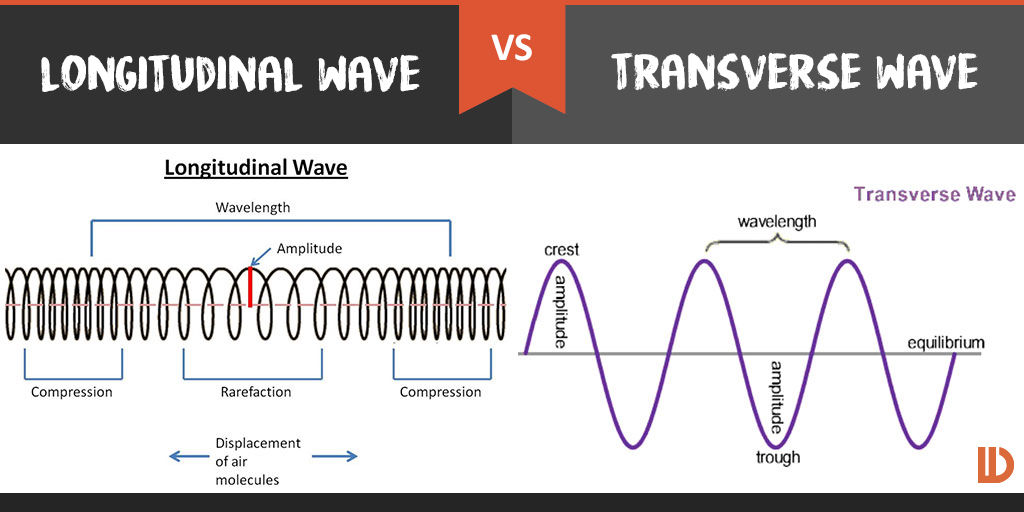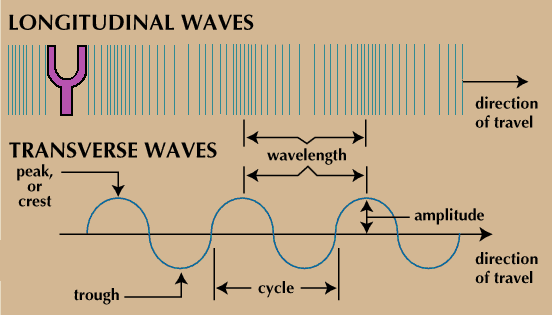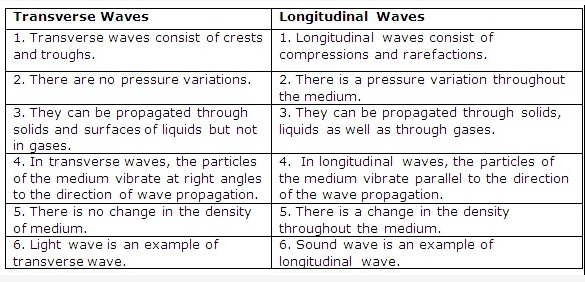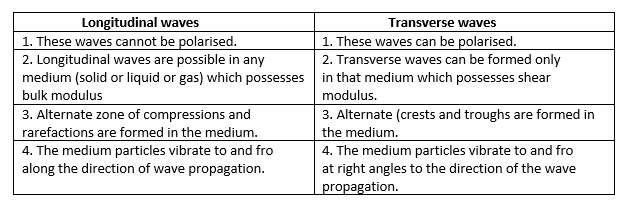Describe the Difference Between Longitudinal and Transverse Waves
The figure below shows a series of snapshots of standing waves that are formed on a string which is fixed at both ends the figure shows successive. A transverse wave is a wave that causes the particles of the given medium to vibrate in the direction of the wave in which it is moving.

Differences Between Longitudinal And Transverse Waves Explained Youtube
For transverse waves the waves move in perpendicular direction to the source of vibration.
. Sound waves in airwaves formed a long a compressed spring seismic waves. In longitudinal waves the medium is displaced parallel to the direction of the wave. A transverse wave is a wave where the movement of the medium is at a right angle to the wave direction.
Waves can be characterized as either longitudinal or transverse waves. To test this you can move a slinky up and down. Main Difference Transverse vs.
6 rows In a longitudinal wave the medium or the channel moves in the same direction with respect to. Longitudinal waves also known as l-waves are waves have the same direction or the opposite direction as the energy transfer. In the longitudinal waves the oscillations of the particles in the medium move in a parallel direction to the direction in which the wave travels.
The difference between a longitudinal wave and a transverse wave is that in a longitudinal wave particles vibrate parallel to the motion of the wave but in a transverse wave particles vibrate perpendicular to the motion of the wave. Who was the first to suggest that light was a transverse wave. Ripples on the surface of water.
Longitudinal waves Particles move left and right making the other particles oscillate. Transverse waves create oscillations that are normal to the direction of propagation but the longitudinal waves create oscillations that are parallel to the propagation of the wave. Radio water rope and electromagnetic waves all travel in a transverse wave.
A longitudinal wave is the one that moves parallel to the direction of waves of particles in motion. That is a straight parallel line above the particle. For instance in the same rope kept horizontally if one introduces a pulse on the left and the right end the energy flows.
In simple explanation the waves follow the same path or the opposite path as the path of the energy transfer. Describe the difference between a longitudinal and a transverse wave. Characteristic of a transverse wave is that the motion of the particle is perpendicular to the motion of the wave.
A longitudinal wave is a wave that causes the particles of the medium to vibrate in the direction. Which can be polarized. Vibrations in a guitar string.
In transverse waves the medium is displaced perpendicular to the direction of the wave. Sound waves and compression waves in a spring. The main difference between transverse and longitudinal waves is that in transverse waves oscillations occur perpendicular to the direction of propagation of the wave whereas in longitudinal waves oscillations occur parallel to the.
Transverse and longitudinal are two different types of waves. The main difference between longitudinal waves and transverse waves is the number of. Are at right angles to the direction of travel and energy.
Examples of transverse waves include. Describe the main difference between longitudinal waves and transverse waves. In a surface wave it is only the particles at the surface of the medium that undergo the circular motion.
A longitudinal wave is where the direction of the particles of the medium move in the same direction as that of the wave. What is Brewsters angle. In a transverse wave the particles of the medium move perpendicular to the waves direction of travel.
Transverse waves have oscillations in many different directions but longitudinal waves have oscillations in only one direction. 6 rows If particle vibrates perpendicular to the direction of motion of wave then the wave is known as. In terms of waves what is the difference between plane-polarized and unpolarized light.
Who discovered polarization by reflection. Then what are the differences between transverse and compressional waves. In transverse waves the oscillations.
A wave that vibrates or oscillates at parallel to along the direction in which energy is transferred the wave is moving. A longitudinal wave is a wave where the movement of the medium is in the same direction as the wave. In tranverse waves the vibrations are at right angles to the direction of wave travel.
In longitudinal and transverse waves all the particles in the entire bulk of the medium move in a parallel and a perpendicular direction respectively relative to the direction of energy transport. A transverse wave is where the direction of the particles of the medium move perpendicularly to the direction as that of the wave. Longitudinal and transverse waves.
Based on what you have learned in the lecture part of the course which of these two types is an electromagnetic wave. The major difference between the two types of waves is in terms of. Transverse waves All oscillations are 90 degrees to the wave motion.
They are similar in the sense that energy is transferred in the form of waves. A wave that vibrates or oscillates at right angles perpendicular to the direction in which energy is transferred the wave is moving. For longitudinal waves the waves move in parallel direction to the source of vibration.
Waves can be longitudinal or transverse. The most common transverse and longitudinal waves are light waves and sound waves respectively. One difference between longitudinal and transverse wave is with regards to dimension.
The difference between transverse and longitudinal waves is the direction the medium of the wave moves in relation to the direction of wave propagation. Vibrations that transfer energy from one place to another. All electromagnetic waves are transverse waves.

What Is The Difference Between A Longitudinal Wave And A Transverse Wave Socratic

Difference Between Transverse And Longitudinal Wave
What Is The Difference Between Longitudinal And Transverse Waves Quora

What Type Of Wave Is Sound Pasco Blog Pasco

3 02 Explain The Difference Between Longitudinal And Transverse Waves Tutormyself Chemistry

Difference Between Longitudinal And Transverse Waves Teachoo

Find Out The Differences Between Transverse And Longitudinal Waves And Complete The Above Table

What Is The Difference Between The Transverse Waves And The Longitudinal Waves Science Online

What Is And Difference Between Longitudinal And Transverse Wave Brainly In
What Are Longitudinal And Transverse Waves Quora

Difference Between Longitudinal And Transverse Wave

What Is The Difference Between Longitudinal Waves And Transverse Waves Cbse Class 11 Learn Cbse Forum

Difference Between Longitudinal And Transverse Wave With Its Practical Applications In Real Life

10 Differences Between Longitudinal And Transverse Waves With Examples Similarities Viva Differences
A List In Tabular Form To Distinguishing Features Between Longitudinal Waves And Transverse Waves Give An Example Of Each B State And Define Characteristics Associated Sound Waves Cbse Class 9 Science

Distinguish Between Longitudinal Waves And Transverse Waves Snapsolve

Longitudinal And Transverse Waves Explanation Difference Teachoo

Write 2 Differences Between Longitudinal Wave And Transverse Wave With One Example In Each Brainly In
Comments
Post a Comment